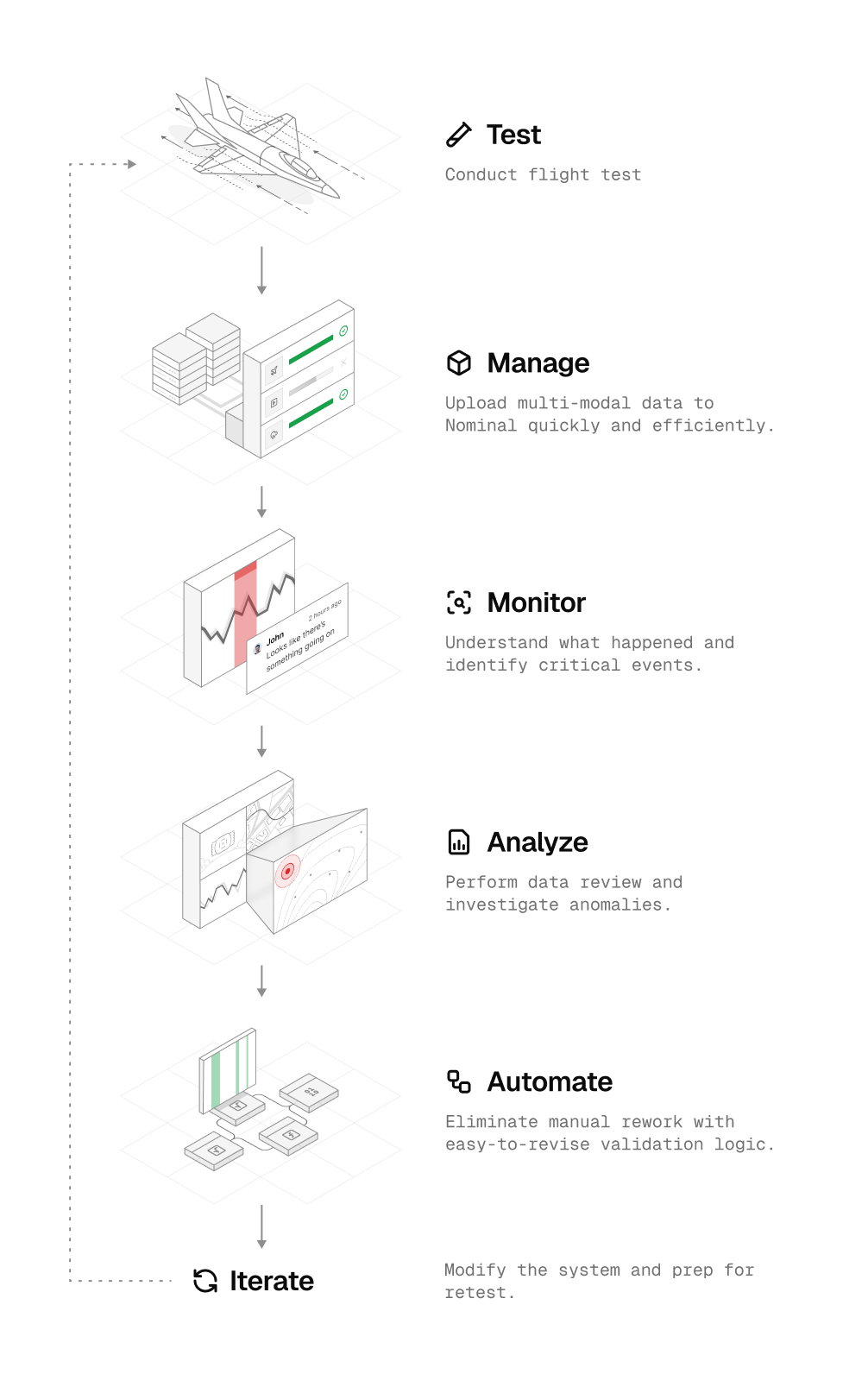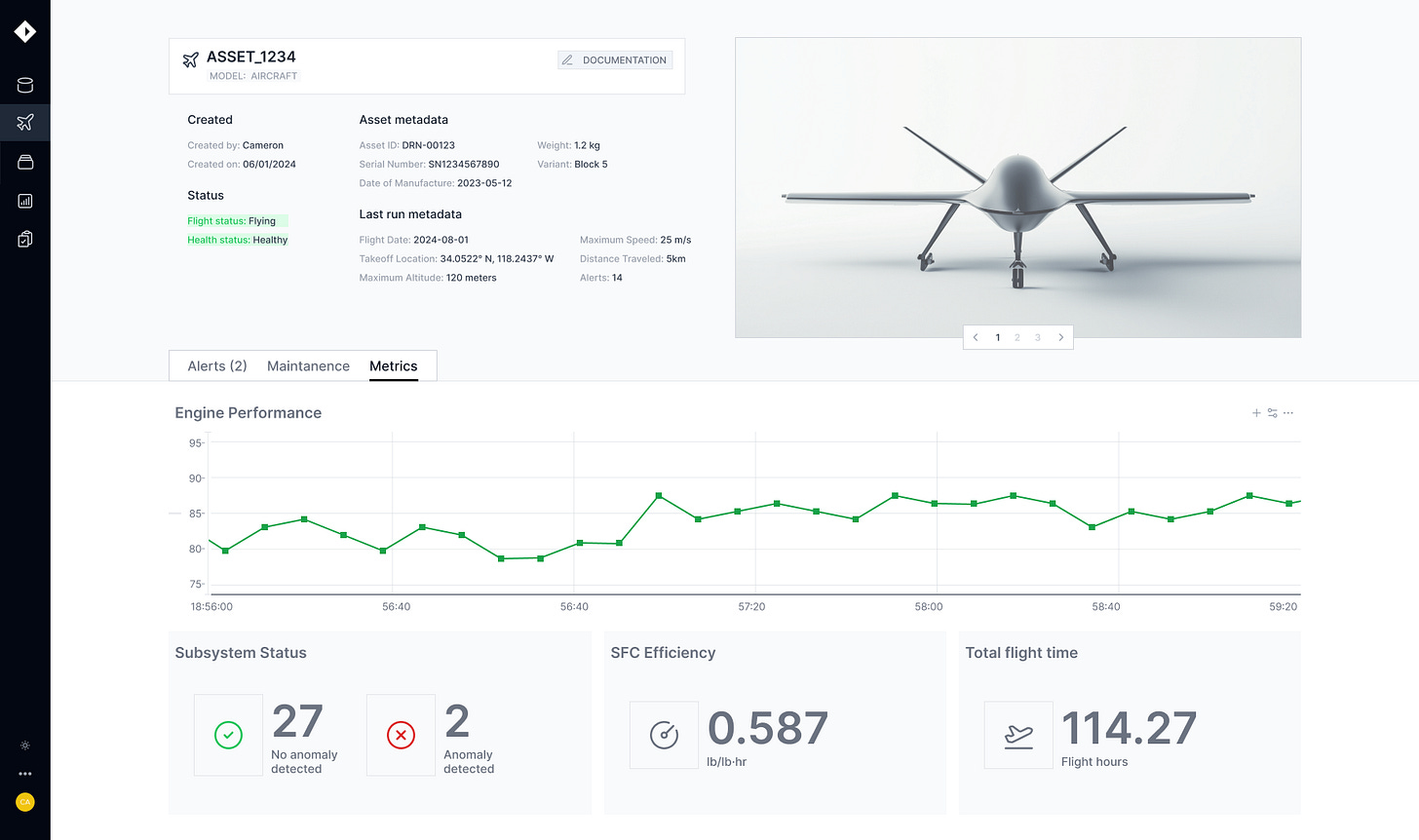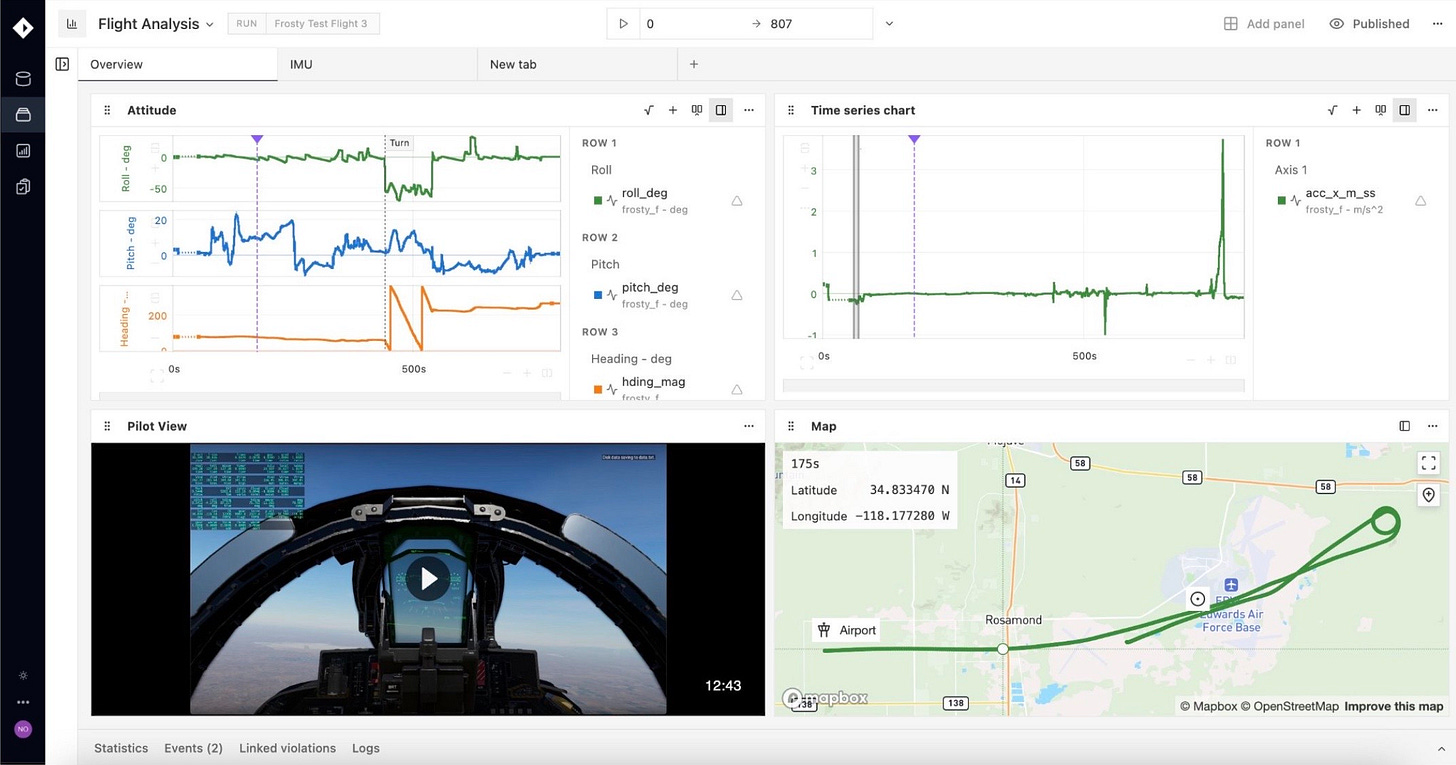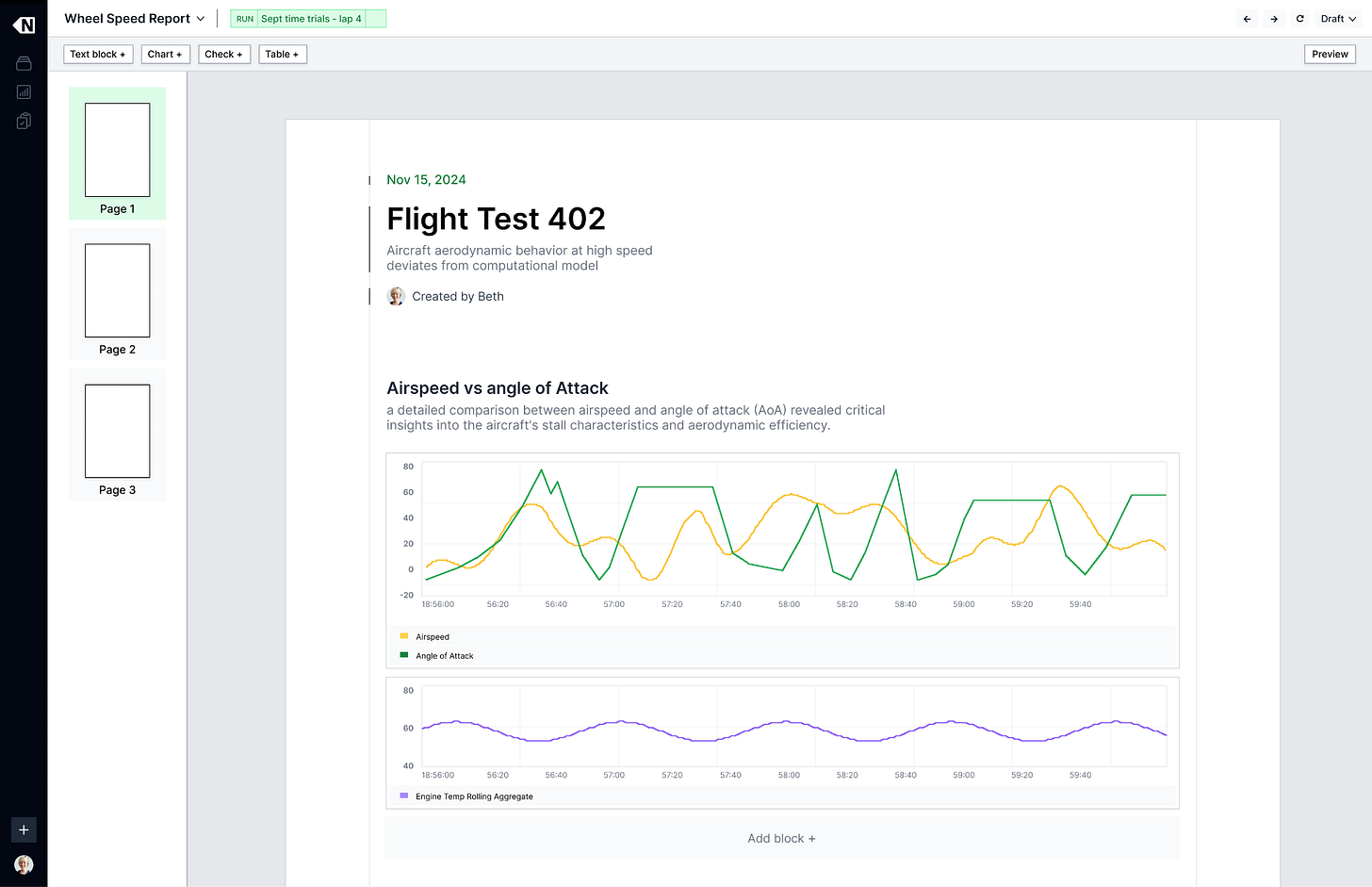Flight Test + Nominal
Accelerating test campaigns for advanced aircraft development and operations
Nominal powers mission-critical hardware engineering with modern analysis tools, real-time observability, and performant data infrastructure—all in one collaborative workspace. The platform is designed to serve hardware and test engineers across many industries, including aerospace, defense, energy, industrials, robotics, and transportation.
One of Nominal’s standout applications is helping teams accelerate flight test campaigns for advanced aircraft like endurance drones, eVTOLs, and supersonic aircraft. As word of these successful partnerships reached the broader flight test community, many have asked to learn more about Nominal. In response, we’re sharing a high-level description of the different aspects of our platform and how they can help teams test quickly and more efficiently.
Overview
The aerospace industry has long been a leader in innovation, and today’s surge in next-generation aircraft is reshaping the future of aviation. While there have been leaps forward in flight technologies, the software used to test and validate these systems has failed to keep up with the pace of innovation.
Test engineers often have to spend their time figuring out how to stitch together siloed, non-purpose-built tools to form a tech stack that suits their needs, instead of dedicating resources to fielding new systems, especially those built for cloud software observability. Alternatively, others have turned to building and maintaining in-house solutions that strain under growing data scales and system reliability requirements demanded by most modern hardware development as soon as production increases.
As a result, the aerospace engineers we talk to frequently share painful stories of:
Waiting hours or days to upload data post-flight only to realize test points were missed
Wrestling with messy data pipelines, incompatible file formats, and changing data schema
Manually comparing results across flights or time-aligning heterogenous data
Fragmented data and siloed workflows leading to lost institutional knowledge or rework
These are many of the reasons why we built Nominal.
From wheels down to clarity in minutes, not hours
Flight test data review should begin before your engines have even cooled down. Nominal gives you the tools to do that.
Nominal allows your engineers to:
Access clean, contextualized datasets from any sensor and any source on-range, all in one place
Validate test results and analyze test points, while ensuring safety and airworthiness at every stage
Perform rapid root-cause analysis to triage issues and update systems
Nominal provides a unified solution for managing, monitoring, analyzing, and automating flight test data. Use our platform to accelerate your end-to-end test cadence, whether with live streaming and real-time alerting or post-test data review.
Built for engineers, by engineers
We encode the lessons learned at organizations like SpaceX, Lockheed Martin, Anduril, NASA, Pratt & Whitney, and Palantir into our software, applying the expertise of engineers who know how to build powerful, scalable test and operations software and high scale data products for some of the world’s most complex industries.
One data stack for development, test, and operations
Nominal enables organizations to manage, monitor, analyze, and automate data generated across simulations, hardware-in-the-loop (HITL) ground tests, field tests, and fleet operations. We work with companies building technologies like traditional aircraft, autonomous vehicles, eVTOL aircraft, as well as other advanced systems.
Nominal’s product
Nominal’s platform allows users to accelerate their test cadence by an order of magnitude. This process is supported by key product capabilities.
Build a data catalog
Ingest and organize data: Create a repository of full-rate data, including vehicle telemetry, video files, spatial data, logs, PDF attachments, etc. Overlay computed events and our integrated weather connector to contextualize the synchronized datasets.
Search and filter: Query channels and filter by metadata to easily find desired data across all tests and assets.
Monitor asset lifecycles
Create detailed asset profiles: Establish a unified view of each aircraft by capturing all associated data, with properties such as flight software version and battery model.
Review lifetime performance: View system health, key metrics, and parameters over time, informing an end-to-end view of the asset lifecycle. Replace Grafana dashboards with dynamic, events-driven timelines.
Perform exploratory analysis
Create custom visualizations: Conduct post-test analysis, quickly pulling data into multi-tab workbooks with time-synchronized plots, interactive maps, and annotated findings.
Transform your data: Compute derived metrics with embedded calculation types (e.g., absolute value, rolling aggregate), engineering constants, and a formula builder. Calculate fuel efficiency or calibrated airspeed without opening MATLAB.
Introduce automation
Surface test points and anomalies automatically: Author complex validation logic to identify important events such as test points, maneuvers, anomalies, and vehicle states across all tests.
Perform collaborative data review: Work with your team to review and resolve findings with priority-based alerting, issue assignment, link generation, real-time comments, and role-based access controls.
Compare and correlate across tests
Understand trends: Construct test-over-test metrics for trending, correlation, and out-of-family analysis. Map a system’s state space using contour plots.
Compare test points: Conduct comparative analysis, calculating output statistics and metrics for ranges of time meeting similar input conditions. Adjust flight test plans accordingly.
Generate dynamic reports [release: Q1’25]
Create context-rich reports: Produce detailed reports for internal reviews or regulatory compliance, complete with multi-user editing and version control, in just a few clicks.
Embed live data objects: Link to charts and tables referencing data and artifacts built in-app, and add technical commentary and annotations before exporting to PDF, .png, or other common standards.
Nominal’s data infrastructure
Nominal’s platform is architected to support performant engineering workflows while abstracting away complexities of normalization, compression, and retention, even at petabytes of scale and high rates of ingestion. It also gives users the option to either upload post-processed data or to use our API to live stream data directly.
Data ingestion: Select a preferred ingestion method: either upload common file types (e.g., CSV, Parquet) and industry-standard formats (e.g., Ch. 10, PCAP), or form database connections for low-latency live streaming (e.g., Influx, Timescale, Timestream). Ensure compatibility with existing sources, such as IADS.
Data warehouse: Opt to store your sensor data in Nominal’s time-series database that incorporates best practices in data schema, compression, and optimized compute. Use our tiered storage and caching for high-performance queries. Manage multi-modal data (e.g., video, message logs) with embedded time synchronization and indexed object storage.
Code and no-code inputs: Leverage DSL-based compute and Python, MATLAB, and LabVIEW clients to supplement our intuitive, point-and-click UI.
Flexible deployment: Access your data where you need it, how you need it. Deploy across environments, including cloud, on-premises, or hybrid installations.
Nominal’s support model
Our engineers are available to provide support at every stage. In addition to standard software support and management, this includes:
Locating engineers on-site to perform data integration and onboarding
Offering on-call support for rapid troubleshooting
Providing dedicated communications channels to answer users’ questions
Collecting feedback and sharing the latest product updates
Submit the interest form linked above to learn more about Nominal and how our software platform can accelerate your testing cadence and reduce your time-to-milestone.










